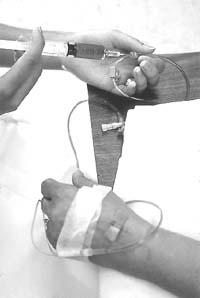Treating cervical cancer
 in what is considered a significant step, the National Cancer Institute ( nci ), Bethesda, usa, has urged thousands of us doctors to use chemotherapy along with radiation while treating cervical cancer after studies showed that such treatment can halve death rates. Randomised clinical trials conducted in various hospitals across the us showed that women benefitted when radiation therapy and chemotherapy were administered jointly.
in what is considered a significant step, the National Cancer Institute ( nci ), Bethesda, usa, has urged thousands of us doctors to use chemotherapy along with radiation while treating cervical cancer after studies showed that such treatment can halve death rates. Randomised clinical trials conducted in various hospitals across the us showed that women benefitted when radiation therapy and chemotherapy were administered jointly.
Cervical cancer is one of the most common diseases among women after breast cancer. About 400,000 new cases of cervical cancer are diagnosed each year, predominantly among the poor in both the developing and industrialised nations. India accounts for about a quarter of them with an overall rate of about 40 per 100,000, which goes up to over 60 per 100,000 in women who are above the age of 36 years. The disease is most likely to occur between the ages of 30 and 55.
The cervix is the narrow, neck-like opening of the uterus that connects it to the vagina. Various strains of the human papillomavirus ( hpv ), which is sexually transmitted, are responsible for 95 per cent of the cases of cervical cancer. Young cells are most susceptible to precancerous changes that hpv can cause.
In most women exposed to hpv , the immune response prevents the virus from causing harm. However, in some women, the virus is able to survive undetected for many years. It eventually converts cells on the surface of the cervix into cancer cells.
Until now, surgery or radiation therapy alone has been considered the standard treatment for cervical cancer that spreads locally (within the cervix) or regionally (within the pelvis). There is evidence that tumors shrink rapidly with aggressive chemotherapy, but the drugs can be toxic to the patient. However, to cancer therapists, there is no established procedure for combining chemotherapy with radiation. Most studies show that cervical cancer patients treated with a combination of radiation and chemotherapy may not live longer than those treated with radiation alone.
The best approach to fight cervical cancer worldwide, including India, is through risk reduction, that is, delaying first intercourse, fewer sexual partners, use of condoms and early detection through routine Pap tests. Researchers are working on ways to improve or replace the Pap test with more effective techniques and they are also trying to develop a vaccine against hpv . But for the time being, women can be assured that routine Pap screening is crucial to diagnose the disease early.
New studies were carried out by three of nci 's Clinical Trials Cooperative Groups, which are consortiums of institutions and physicians that conduct trials jointly. The studies are known as phase III trials, that is, they are studies in which one treatment is compared to another. Each of the trials included several hundred patients suffering from invasive cervical cancer, ranging from disease that had spread within the cervix to disease that had spread to other parts of the pelvis.
In three of the studies, women were divided into groups that received either radiation or radiation plus concomitant chemotherapy (given at the same time as the radiation therapy). The chemotherapy agents used were cisplatin and 5-fluorouracil, also known as 5 fu . In all the three trials, the proportion of women who survived after about three years of follow-up was higher in the groups receiving chemotherapy plus radiation than in those receiving only radiation therapy ( New England Journal of Medicine, Vol 340, No 15).
nci 's clinical announcement states that although the best chemotherapy regimen for cervical cancer has not been determined, significant results were seen using cisplatin alone or cisplatin in combination with 5 fu and other agents.
Previous studies have suggested that chemotherapy and radiation therapy, when applied together, have an improved effect. The reason for this is not clear, but researchers think it may be that chemotherapy makes cells more sensitive to radiation, or vice versa. It is also possible that chemotherapy stops cancer cells from repairing the damage caused by radiation.
Edward Trimble, head of surgery at the nci 's therapy evaluation programme, said the findings are "very significant' and results, if used as the new standard treatment, could help save half the patients who die now, besides radically changing the way women with cervical cancer are treated. About 90 per cent of the cases could, however, be prevented through regular gynaecological tests and pap smears.
In an unusual step, three of the reports were posted on the website of the New England Journal of Medicine (www.nejm.org ) in an effort to inform the medical community about the findings. These reports will be appearing in the journal that broke its very rigid policy of embargo by announcing the results before formal publication as these path-breaking studies have immediate and significant public health importance. Of the two other studies, one will be published in the Journal of Clinical Oncology and the second in the Society of Gynaecologic Oncologists later this year.
The side-effects of chemotherapy and radiation therapy given at the same time were mainly leaukemia (low number of white blood cells), nausea and vomiting. These are more frequent and severe in the women who have had the combination therapy than in those who had radiation alone. In general, these adverse effects were temporary and manageable. For instance, women with leaukemia stopped chemotherapy until their blood counts rose and then were able to resume the treatment.
